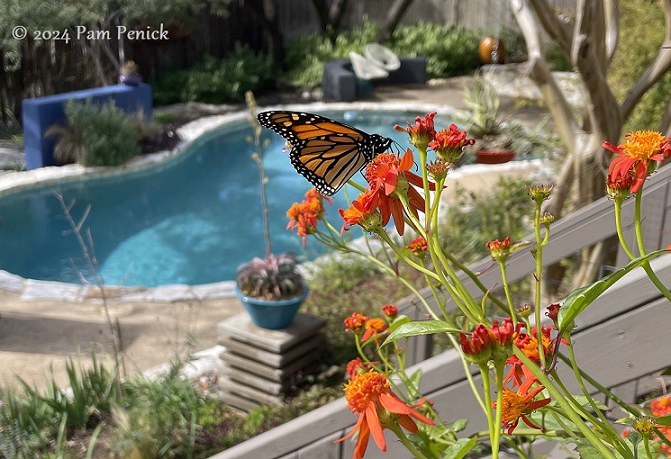Indulge an orange crush with Mexican flame vine

Last year I planted Mexican flame vine (Senecio confusus) at the base of the deck and impatiently waited all summer for it to do anything. And then, oh my gosh, it exploded in fall with pumpkin-orange flowers that drew in bees and butterflies like bears to honey.

Our first freeze came late — not until early January — and so I got to enjoy the flowers for months. On Christmas Day they were glorious. I took these pics on January 5th, right before the end, as the flowers fed late-migrating monarch butterflies.

Honeybees were busy among the frilly-capped flowers too.

It was quite a payoff for an annual vine. Planting it against the deck meant I got to enjoy its beauty every day from October through early January. I could even see it while sitting at the kitchen table.

A red admiral butterfly added to the orange extravaganza.

I imagine many gardeners grow Mexican flame vine from seed, but I planted mine from a 1-gallon pot. A wire trellis against the deck gave it an easy way to climb.

Full sun and once-a-week watering kept it happy, although I probably gave it supplemental drinks from the hose during the hellish part of last summer. I can’t remember now.
When the first hard freeze finally came, I said goodbye to this beautiful vine. Because it’s an annual in my zone 8b (or 9a, as they now claim), I pulled it out during the big cutback. For some reason I didn’t plant another one this spring. Instead I fell for a red ‘Lady Margaret’ passionflower, upon whose leaves Gulf fritillary butterflies are eagerly laying eggs. Passionflowers are their larval host plants, so I’m still helping out butterflies. And hopefully this fall I’ll see another good bloom show. We’ll see!
I welcome your comments. Please scroll to the end of this post to leave one. If you’re reading in an email, click here to visit Digging and find the comment box at the end of each post. And hey, did someone forward this email to you, and you want to subscribe? Click here to get Digging delivered directly to your inbox!
__________________________
Digging Deeper
Come learn about gardening and design at Garden Spark! I organize in-person talks by inspiring designers, landscape architects, authors, and gardeners a few times a year in Austin. These are limited-attendance events that sell out quickly, so join the Garden Spark email list to be notified in advance; simply click this link and ask to be added. Season 8 kicks off in fall 2024. Stay tuned for more info!
All material © 2025 by Pam Penick for Digging. Unauthorized reproduction prohibited.


Beautiful photo! I love that vine 🙂
It has such an explosion of color in fall.
Wow, that is a really stunning flowering vine, Pam. So, I guess it didn’t self sow?
Nope, no seedlings from it this spring.
I planted one for the first time on May, I’m glad I read this because I was expecting flowers this month, nice to know it can be flowering during fall. Your pictures are very beautiful. Thank you.
Look for a big show this fall, Doris. And thanks for the compliment!
Love love love your website. But, I do have a question. I read on Birds and Blooms that the red passion vine “passiflora racemosa” is “toxic to our native butterflies.” I suppose there are lots of red passion vines. I hope the one you planted – Lady Margaret is NOT this variety. I did a quick search, and couldn’t find an answer.
Thanks for your wonderful website.
Victoria
I have not heard about this but hope it’s not a problem for ‘Lady Margaret’. According to Snowdrop Farm’s website, Passiflora ‘Lady Margaret’ is a hybrid of “P. miniata (formerly P. coccinea) x P. incarnata alba.”